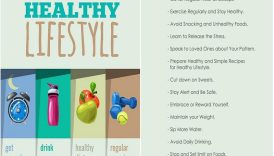The Science Behind Crafting an Effective Healthy Lifestyle Plan

Understanding the Basics of Health and Wellness
Importance of Nutrition
Nutrition plays a vital role in overall health and wellness. It’s often said that you are what you eat, and this adage holds considerable truth. A balanced diet not only fuels the body but also enhances mental clarity and emotional stability. For example, someone who regularly consumes fruits, vegetables, whole grains, and lean proteins may experience increased energy levels throughout the day compared to someone whose diet is high in processed foods and sugars. Key components of good nutrition include:
- The Science Behind Crafting an Effective Healthy Lifestyle Plan
- Understanding the Basics of Health and Wellness
- Importance of Nutrition
- Benefits of Physical Activity
- Setting Realistic Health Goals
- SMART Goal Setting
- Creating a Realistic Timeline
- Incorporating Mindfulness and Stress Management
- Practicing Mindful Eating
- Techniques for Stress Reduction
- Building a Support System for Long-Term Success
- Surrounding Yourself with Positive Influences
- Importance of Accountability Partners
- Monitoring Progress and Making Adjustments
- Tracking Health Indicators
- Modifying Your Plan as Needed
- Variety: Including a range of food types ensures that the body receives a broad spectrum of nutrients.
- Moderation: Practicing portion control helps prevent overeating, which is crucial for maintaining a healthy weight.
- Hydration: Drinking plenty of water is essential for maintaining energy levels and supporting bodily functions.
Benefits of Physical Activity
Physical activity, much like nutrition, is fundamental to health and wellness. It goes beyond weight management; regular exercise can improve mood, boost energy levels, and even enhance cognitive function. Take, for instance, the experience of someone who commits to a daily walk; not only do they become physically stronger, but they also find a significant improvement in their mental state, often using this time for reflection or stress relief. The benefits of physical activity are plentiful, including:
- Improved Cardiovascular Health: Engaging in activities like running, cycling, or swimming strengthens the heart.
- Enhanced Muscle and Bone Strength: Resistance training supports muscle growth and bone density.
- Better Mental Health: Exercise releases endorphins, which can help alleviate symptoms of anxiety and depression.
To wrap it up, understanding the importance of nutrition and the benefits of physical activity sets the foundation for a healthier lifestyle. These components work hand in hand, nurturing both the body and mind, leading to improved overall well-being. By incorporating both good nutritional habits and regular exercise into daily routines, individuals can pave the way for long-term health.
Setting Realistic Health Goals
SMART Goal Setting
After grasping the fundamentals of nutrition and physical activity, it’s time to set health goals that are not only ambitious but also achievable. This is where the SMART criteria come into play. SMART stands for Specific, Measurable, Achievable, Relevant, and Time-bound. This simple framework can turn vague aspirations into actionable plans. For instance, instead of saying, “I want to lose weight,” a SMART goal would be: “I will lose 10 pounds in three months by exercising four times a week and following a meal plan that includes whole foods.” Each aspect of this goal clarifies what needs to be done:
- Specific: It clearly states the desired weight loss.
- Measurable: The weight loss is quantifiable.
- Achievable: Setting a realistic weight loss target ensures it’s attainable within the given time frame.
- Relevant: The goal aligns with the individual’s desire to improve health and fitness.
- Time-bound: It provides a deadline to encourage consistent effort.
Creating a Realistic Timeline
Along with setting SMART goals, developing a realistic timeline is crucial for success. It’s tempting to try and achieve too much too quickly, but this often leads to burnout or discouragement. A personal anecdote illustrates this well—a friend once committed to a grueling workout routine with the plan to run a marathon in just three months. Unfortunately, the commitment overwhelmed her, leading to injury and frustration. To avoid such pitfalls, consider breaking your goals into smaller, manageable milestones. For instance:
- Month 1: Focus on increasing daily physical activity, such as walking 10,000 steps a day.
- Month 2: Start a structured strength training program twice a week.
- Month 3: Gradually increase running distance or incorporate interval training.
Creating a timeline not only helps space out the effort but also builds confidence as you celebrate each small achievement. By following the SMART framework and establishing a realistic timeline, individuals can effectively work towards their health goals, maintaining motivation and making adjustments along the way. This approach ultimately fosters a sustainable lifestyle change that can lead to lasting results.
Incorporating Mindfulness and Stress Management
Practicing Mindful Eating
As individuals progress in their health journeys, incorporating mindfulness can significantly enhance their overall experience, especially when it comes to eating. Mindful eating encourages a deeper connection with food, guiding individuals to focus on the flavors, textures, and aromas of what they consume. It transforms mealtime into an opportunity for self-reflection rather than a rushed obligation. Consider this scenario: someone sits down to enjoy a meal after a hectic day. Instead of mindlessly scrolling through their phone or tackling work emails, they take a moment to appreciate their food by engaging their senses. They notice the vibrant colors of the vegetables, savor the blend of spices, and chew slowly to enjoy each bite. This approach not only fosters better digestion but can also lead to healthier eating habits, such as portion control. To practice mindful eating, consider these tips:
- Eliminate Distractions: Turn off electronic devices and focus on the meal.
- Take Smaller Bites: This allows time to appreciate the flavors and prevents overeating.
- Notice Your Body’s Signals: Tune in to hunger and fullness cues, recognizing when to eat and when to stop.
Techniques for Stress Reduction
Alongside mindful eating, integrating stress management techniques into daily routines can drastically improve overall well-being. High levels of stress can hinder progress toward health goals, so finding effective ways to manage it is essential. A relatable example involves someone juggling family, work, and personal commitments. Instead of feeling overwhelmed, they choose to incorporate a few simple stress-reduction techniques:
- Deep Breathing: Practicing deep breathing exercises for just five minutes a day can calm the mind and reduce anxiety.
- Regular Exercise: Physical activity, whether a brisk walk or yoga, is proven to release endorphins that boost mood.
- Journaling: Writing thoughts and feelings can serve as an emotional outlet, providing clarity and reducing mental clutter.
By diligently practicing mindful eating and employing stress reduction techniques, individuals can create a healthier relationship with food and life. These practices not only complement their nutrition and physical activity efforts but also contribute to a balanced and fulfilling lifestyle. Integrating mindfulness into everyday routines ultimately cultivates a sense of peace, making the health journey even more rewarding.
Building a Support System for Long-Term Success
Surrounding Yourself with Positive Influences
As individuals continue on their journey of health and wellness, creating a support system is crucial for maintaining motivation and achieving long-term success. One of the most effective ways to do this is by surrounding oneself with positive influences. When the people around you share similar health goals or values, it can create an encouraging environment that fosters growth and resilience. Take a moment to reflect on the last time you had a tough day and a friend or family member lifted your spirits. Those interactions matter! Having friends who celebrate your achievements, no matter how small, can significantly impact your mindset. This support not only encourages perseverance but also helps to create a sense of community. To cultivate a network of positive influences, consider the following:
- Join Health-focused Groups or Clubs: Whether it’s a local running club or a nutrition workshop, being part of a community can keep you energized.
- Limit Time with Negative Influences: Recognize those who may inadvertently discourage your wellness journey and find ways to spend less time with them.
- Engage with Online Communities: Many social media platforms have groups centered around health and wellness, offering support and sharing experiences.
Importance of Accountability Partners
Another invaluable aspect of building a support system is having an accountability partner. This is someone with whom you can share your goals and who will check in on your progress. The commitment to report back can be a strong motivator in itself, helping to keep you on track. The idea of accountability is illustrated by a personal story: a colleague decided to embark on a fitness journey. They didn’t tackle it alone; instead, they paired up with a friend who had similar goals. Their shared workouts and weekly check-ins allowed them to celebrate milestones together and navigate challenges as a team. Here are a few ways to establish accountability:
- Set Regular Check-ins: Schedule weekly or bi-weekly meetings, either in-person or virtually, to discuss progress and setbacks.
- Share Goals Publicly: Announcing your goals on social media can create external accountability while also garnering support from friends and family.
- Create a Reward System: Celebrate achievements together, whether it’s treating yourselves to a spa day or enjoying a special meal.
By surrounding oneself with positive influences and establishing accountability partners, individuals can foster a healthy support system that significantly boosts the chances of long-term success in their health and wellness journey. This collaboration creates a sense of belonging and reinforces motivation, making the pursuit of health an enjoyable and shared experience.
Monitoring Progress and Making Adjustments
Tracking Health Indicators
As individuals build a supportive environment for their health and wellness journey, it’s equally important to monitor progress and make necessary adjustments. Tracking health indicators provides valuable insights into one’s journey, allowing for informed decisions about future steps. These indicators can include weight, body measurements, fitness levels, and even mental well-being. For example, consider someone who has set a goal to improve their cardio fitness. Instead of solely focusing on weight loss, they decide to track their running speed and endurance over time. They begin by measuring how far they can run in a set period. Over weeks, they consistently log their distances and times, gaining motivation as they see improvement. Some effective ways to track health indicators include:
- Fitness Apps: Many applications automatically log workouts, food intake, and other health metrics, making it easy to monitor progress on the go.
- Journals: Maintaining a health journal can be a great way to reflect on feelings, achievements, and setbacks. This personal touch can provide insights beyond mere numbers.
- Regular Assessments: Schedule monthly check-ins to review progress, such as taking body measurements or doing fitness tests.
Modifying Your Plan as Needed
As one tracks their progress, the importance of modifying goals and plans cannot be overstated. Flexibility is key to long-term success. Life is full of unexpected twists and turns, and what worked well initially may need to be adjusted along the way. A relatable example is when someone sets a goal to attend three fitness classes per week but then finds that their work schedule becomes busier. Instead of feeling defeated, they modify their plan by opting for shorter, at-home workouts that can be done at their convenience. This adjustment allows them to stay committed without feeling overwhelmed. Consider these approaches for modifying your plan:
- Reassess Goals Regularly: Every few months, evaluate if the initial goals are still relevant or achievable. Are there new interests or challenges that have emerged?
- Stay Open to Change: Be willing to try different activities or dietary approaches. If one method doesn’t resonate, explore alternatives without self-judgment.
- Listen to Your Body: If fatigue or discomfort arises, treat it as a sign to adjust the intensity of workouts or even incorporate rest days.
By tracking health indicators and making necessary adjustments, individuals can remain engaged and motivated in their health journey. This proactive approach not only helps sustain progress but also empowers individuals to create a personalized path that aligns with their evolving goals and lifestyle. Ultimately, regular evaluation and adaptation are essential to achieving and maintaining a healthy, balanced life.




